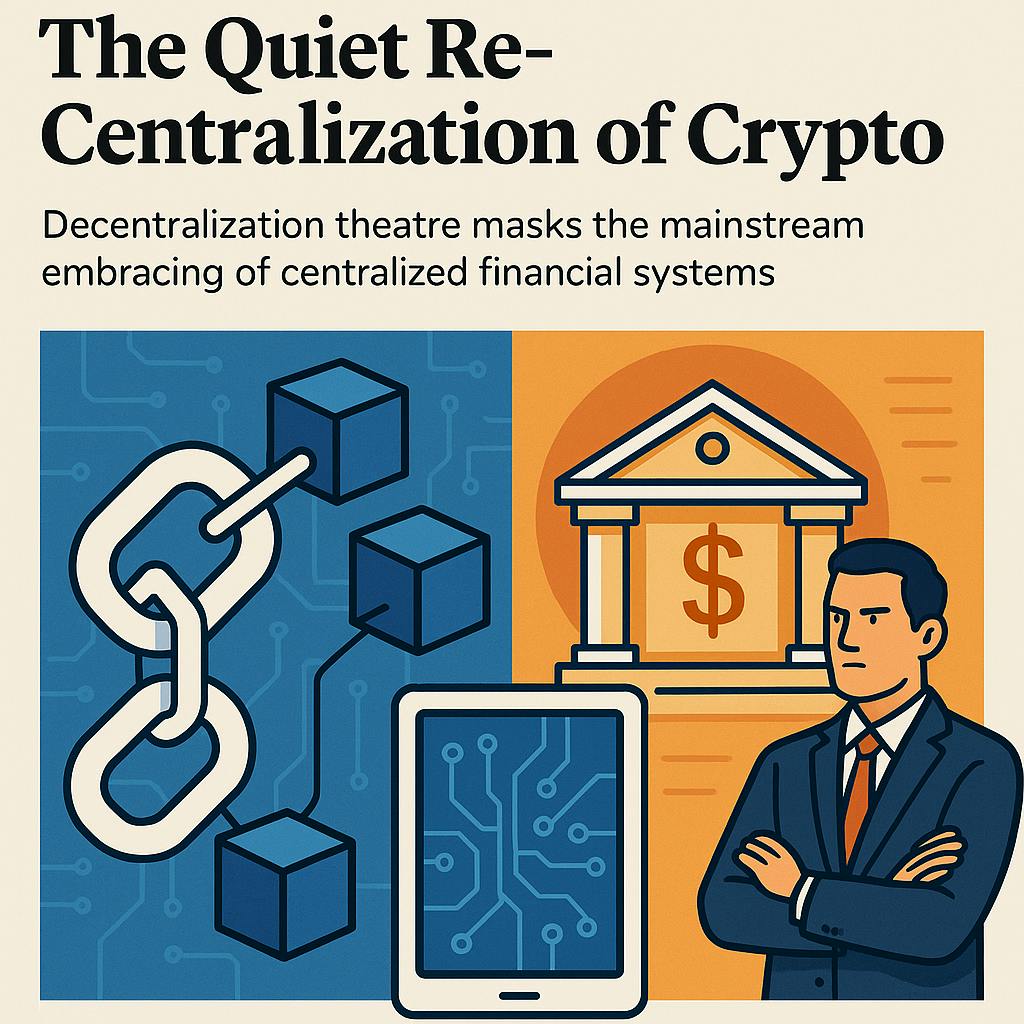The numbers tell a story of maturation. The value of tokenized real-world assets has
By every metric, crypto is achieving mainstream adoption. Yet I've spent enough years building financial infrastructure to recognize an uncomfortable pattern: we're not witnessing the triumph of decentralization. We're watching its quiet replacement with centralized systems wearing blockchain aesthetics.
If SWIFT was postal mail—reliable but slow and expensive—tokenization was supposed to be the email era of finance: instant, accessible, transformative. Instead, we're building a system that delivers the speed but preserves the same gatekeepers.
The uncomfortable truth: crypto is running the risk of becoming exactly what it set out to disrupt.
The Centralization Hidden in Plain Sight
Here's what's actually happening. When Circle freezes USDC addresses on regulatory command, when major stablecoin issuers build censorship capabilities into their smart contract architecture, we've created infrastructure that looks decentralized but, in fact, operates under centralized control at critical junctures.
Your DEX transaction executes on-chain beautifully—until it settles in USDC or another centrally-controlled stablecoin. At that moment, you're operating within a system where someone else holds the power to freeze or block your transaction. The decentralization was theatre. The control point was always there, just moved one layer deeper.
I'm not arguing this is inherently wrong. Financial systems serving billions require certain controls, among them: KYC verification, sanctions compliance, asset freezing when legally mandated. The problem isn't that these controls exist. The problem is marketing centralized infrastructure as decentralized innovation, creating expectations the system cannot fulfill.
Why Re-Centralization Is Structural
Three converging forces make this trajectory nearly inevitable.
Regulatory compliance favors centralized operators. Every major jurisdiction requires transaction monitoring, KYC/AML controls, and asset freezing capabilities. Implementing these efficiently requires centralized compliance systems and regulatory relationships that cost millions. Decentralized protocols can't meet these standards without introducing the exact control points they were designed to eliminate.
Infrastructure dependencies concentrate power. Even decentralized protocols depend on centralized chokepoints: cloud providers hosting nodes, oracles feeding price data, stablecoin issuers providing liquidity, payment processors managing fiat on-ramps. Each dependency creates a censorship point. When you convert crypto to traditional currency, you re-enter systems with compliance requirements that override prior autonomy.
Economic barriers drive consolidation. Operating compliant infrastructure requires substantial capital for licensing, legal teams, compliance systems, and regulatory relationships. These barriers favor well-capitalized institutions over distributed networks, driving consolidation around institutional players who control critical infrastructure.
What This Looks Like in Practice
What we are left with is not a recalibration of finance. It's a hybrid of old and new that disappoints everyone.
Traditional institutions are completing their blockchain integration now, building efficient tokenized markets under familiar regulatory frameworks with centralized controls. This delivers genuine utility—settlements compressed from days to minutes, fractional ownership of illiquid assets, programmable compliance. Wall Street is absorbing blockchain while preserving its power structures.
A smaller segment will maintain genuinely decentralized infrastructure in regulatory grey zones, accepting severe limitations in scale and institutional adoption. These systems preserve censorship resistance for users willing to accept complexity and minimal integration with traditional finance.
Most users—probably 95%—will choose centralized interfaces because they're faster, simpler, and regulated. This hybrid provides perfect cover: we speak of decentralized foundations while building centralized systems on top, using the language of financial sovereignty to market infrastructure that delivers neither.
The Real Risk
The existential threat isn't regulatory crackdowns or market crashes. It's blockchain becoming a modest efficiency upgrade to existing finance while abandoning its transformative potential.
Government bonds settling in 30 seconds instead of three days represents genuine progress. But this improvement does not challenge who controls monetary policy, capital market access, or transaction approval. When blockchain becomes an infrastructure choice for institutions rather than an alternative to institutional control, we've achieved adoption while losing purpose.
Building blockchain infrastructure for government and institutional deployment has taught me what integration actually requires: permissioned layers where authorities access transaction data, programmable policy enforcement for automatic compliance, ability to freeze assets when legally mandated. At Venom Foundation, we've designed architecture specifically to address this tension, launching arbitrary workchains that allow public, private, and consortium configurations to coexist, and enabling compliance where required while preserving decentralized foundations where possible.
These capabilities aren't optional for moving trillions in institutional assets. Governments will require them. The question isn't whether these controls should exist, but whether the underlying architecture maintains meaningful decentralization even when upper layers don't, and whether we're honest about which layer users actually interact with.
What Honest Assessment Demands
Projects that survive will deliver real utility—faster settlement, lower costs, broader access—rather than promise ideological purity they cannot maintain at scale.
But utility through centralized infrastructure wearing the robes of decentralization represents a hollow victory for an industry that began with ambitions to rebuild financial systems according to different principles. The $24 billion in tokenized assets represents genuine progress. If that progress recreates the same centralized control structures crypto promised to eliminate, we need intellectual honesty to stop calling it decentralization and call it what it is: traditional finance with better technology.
The future of finance is being written in code, and blockchain provides the foundation. But whose code, under whose control, serving whose interests—those questions will determine whether this transformation fulfills crypto's original promise or simply modernizes the systems it was meant to replace.


